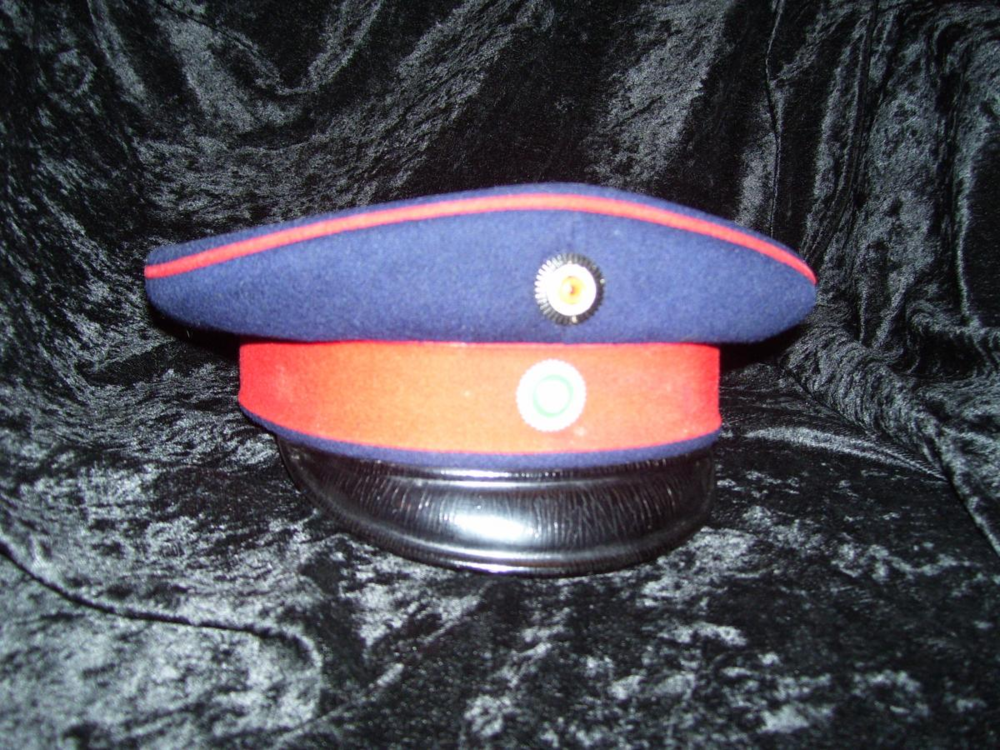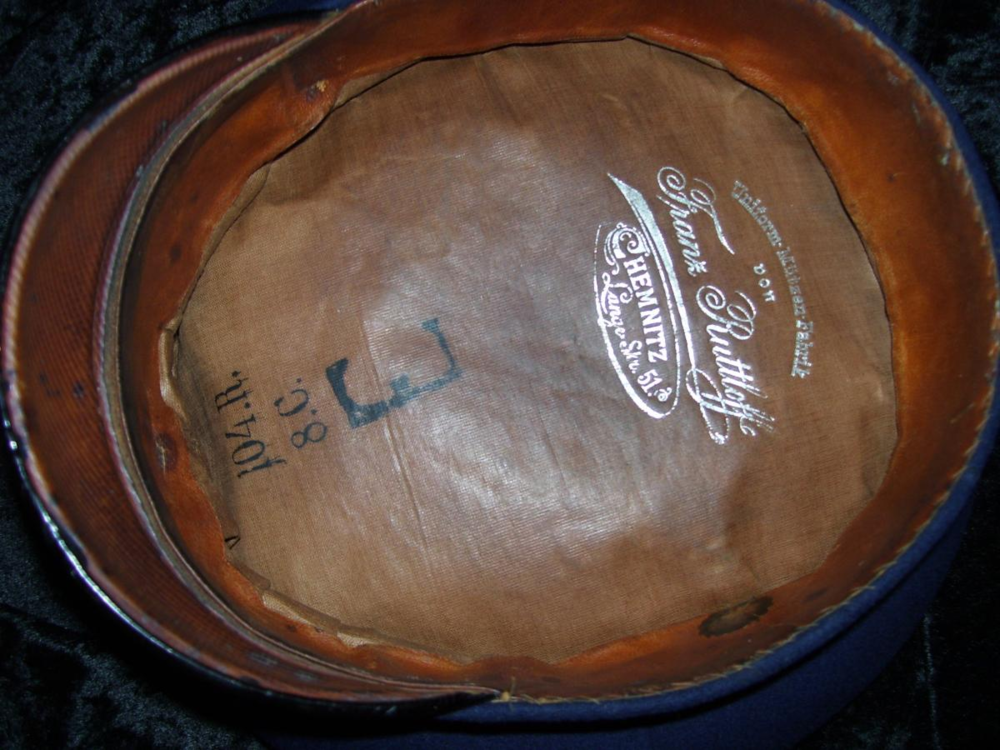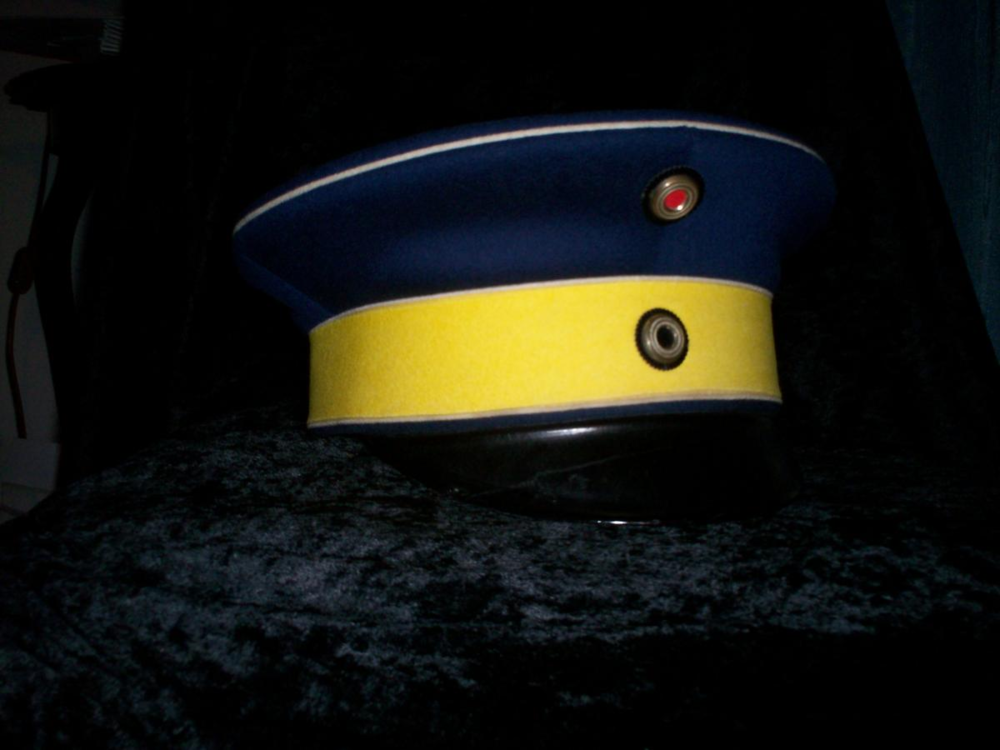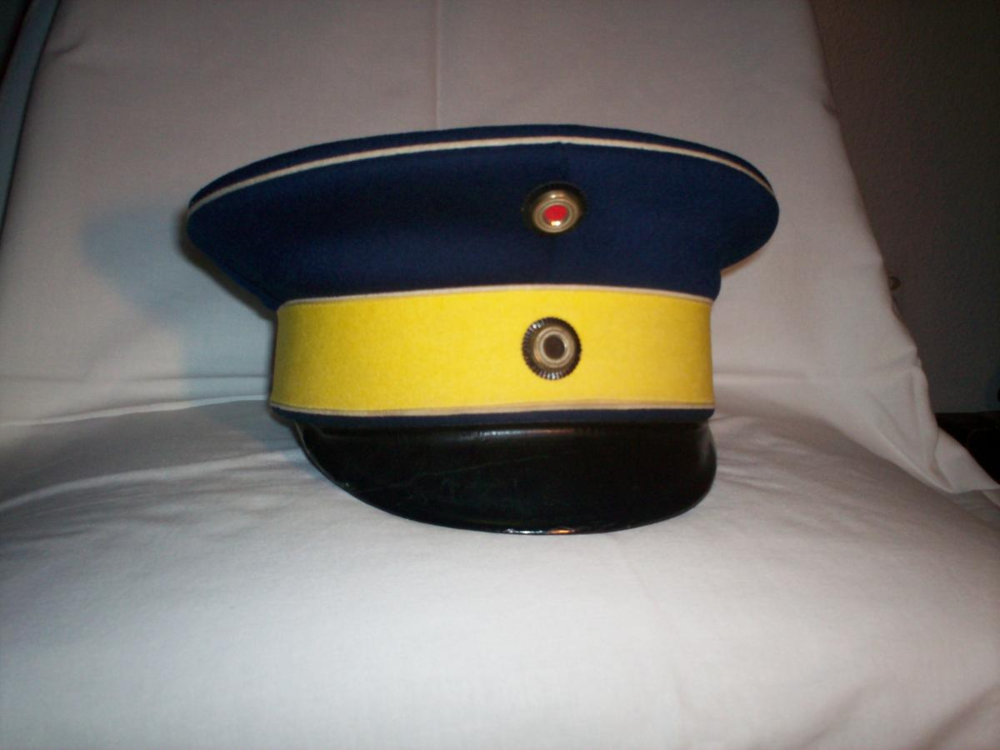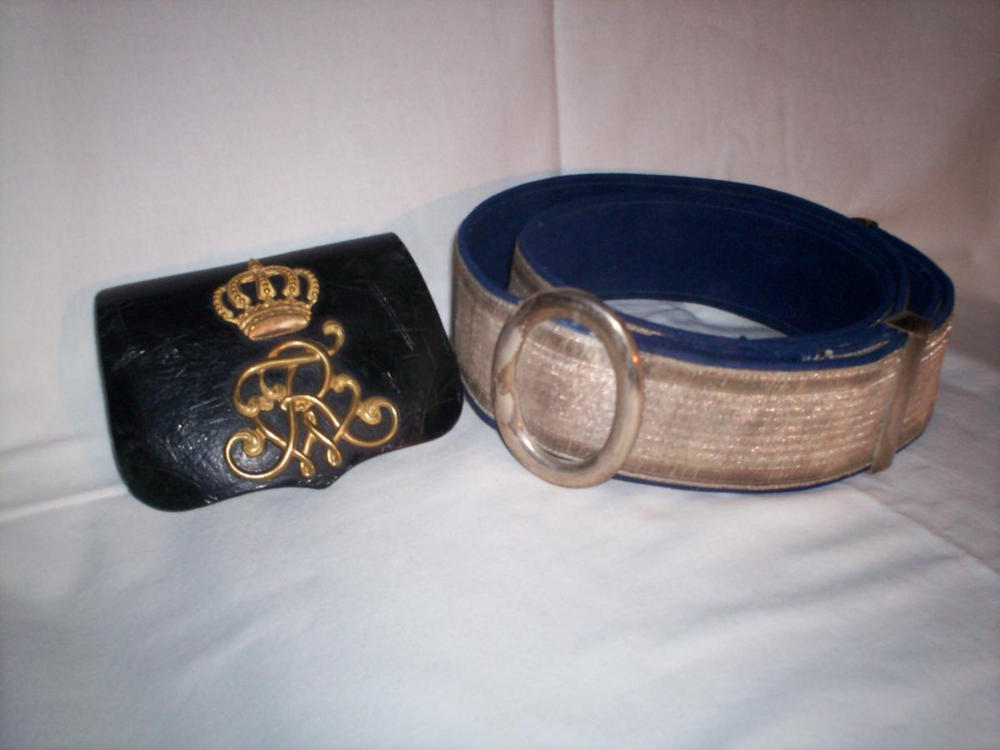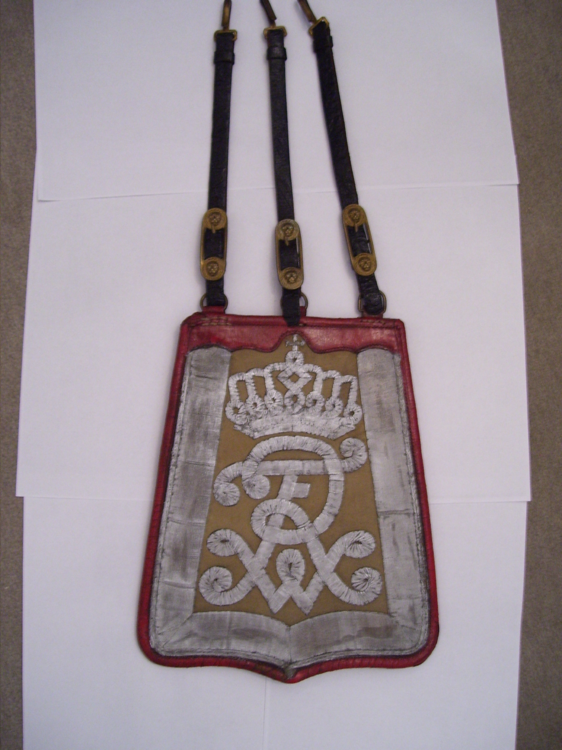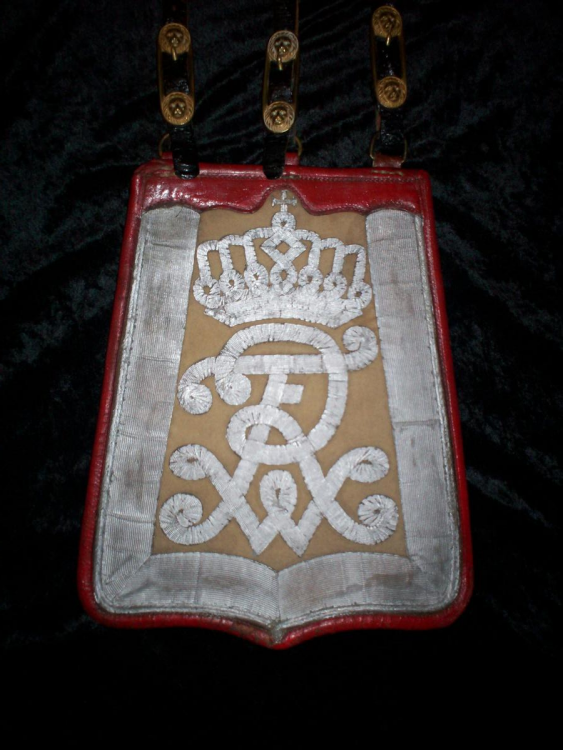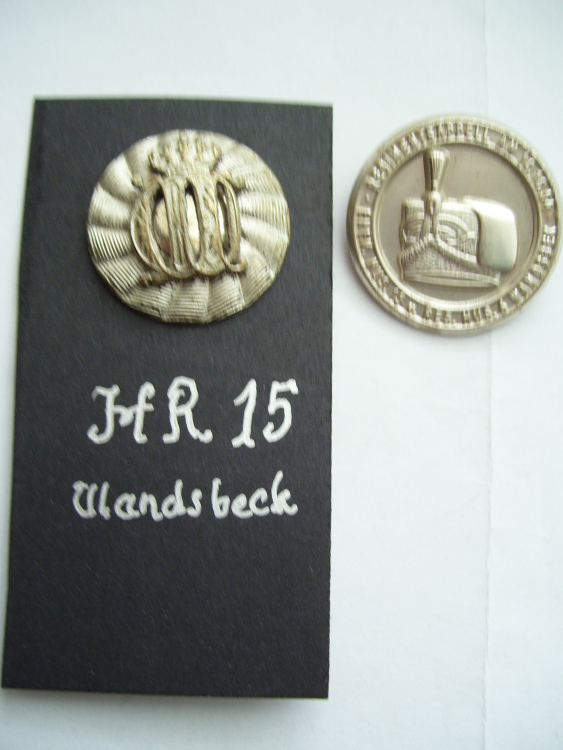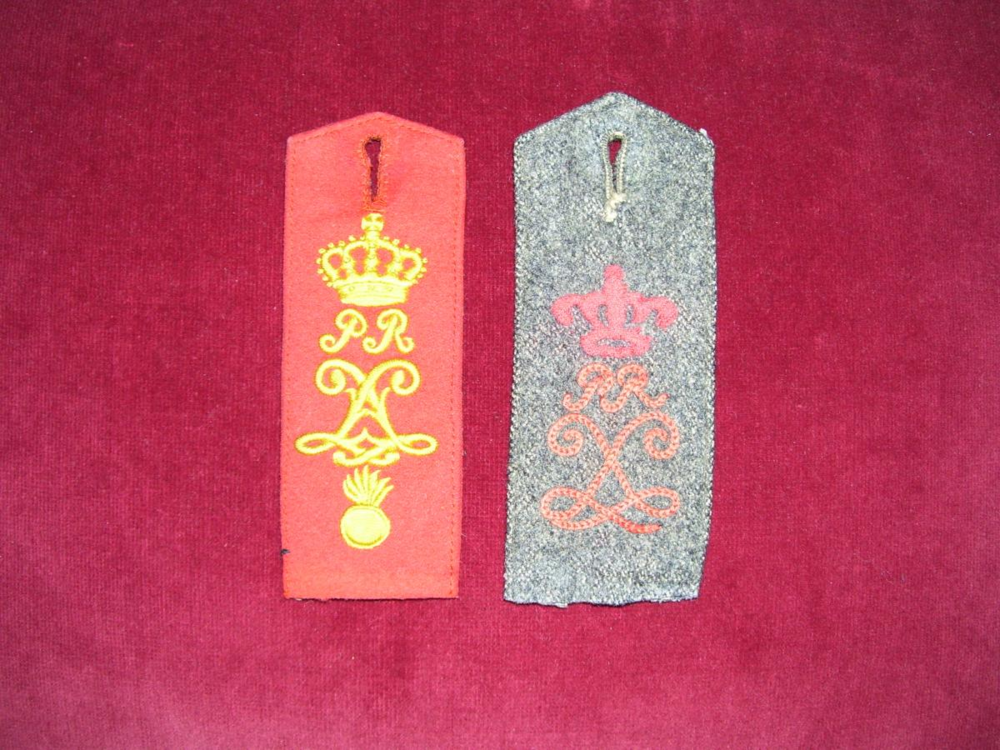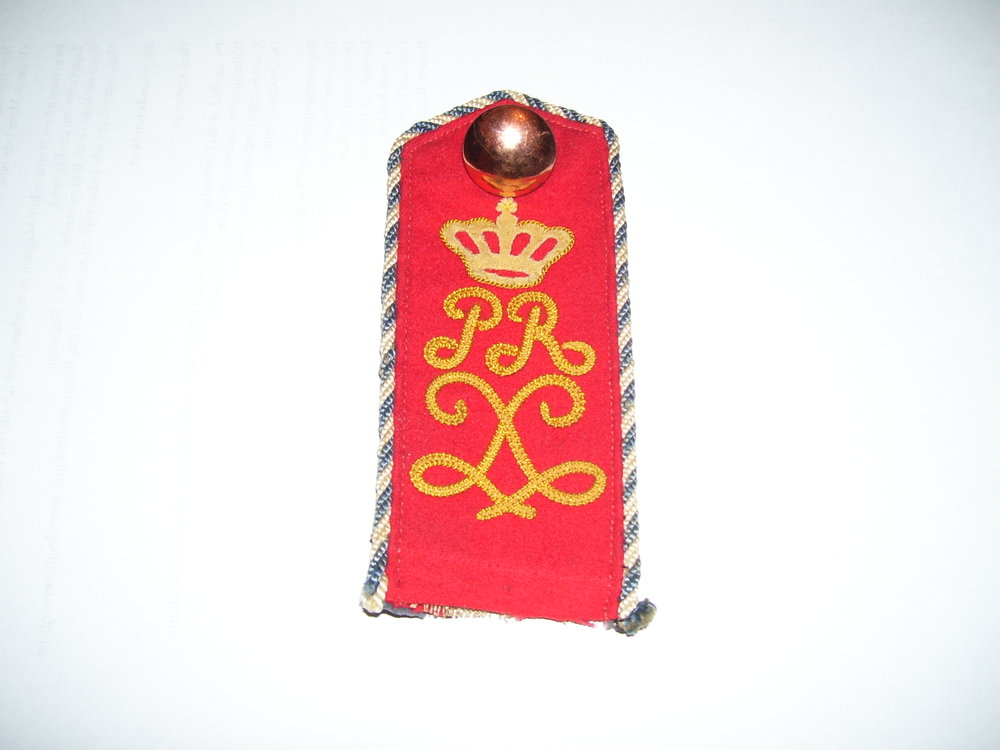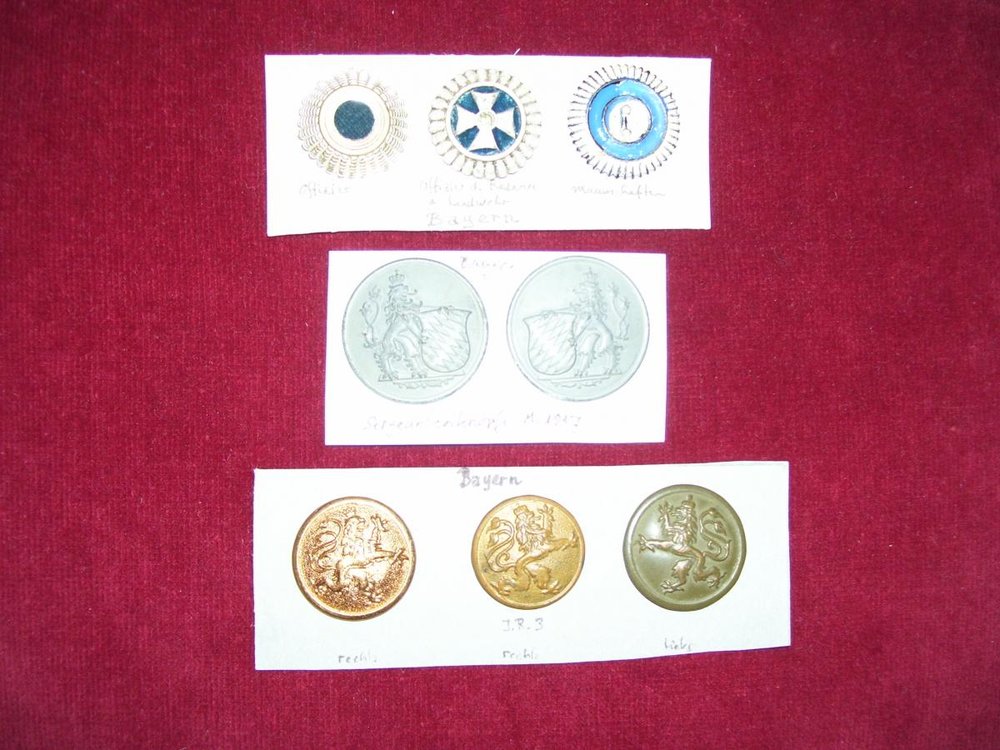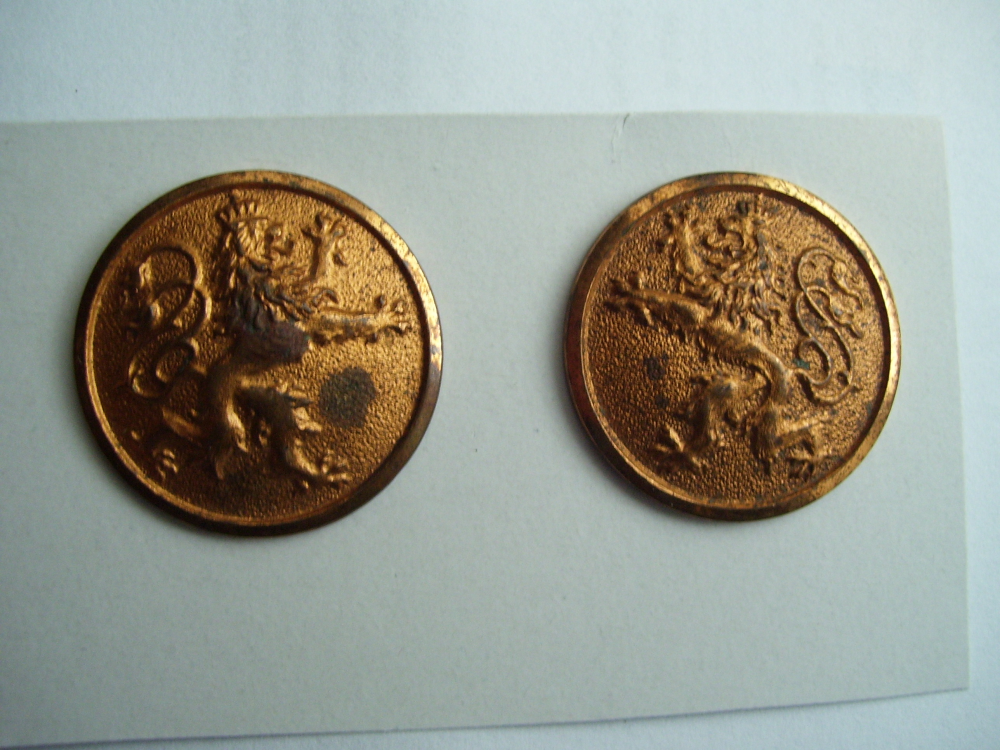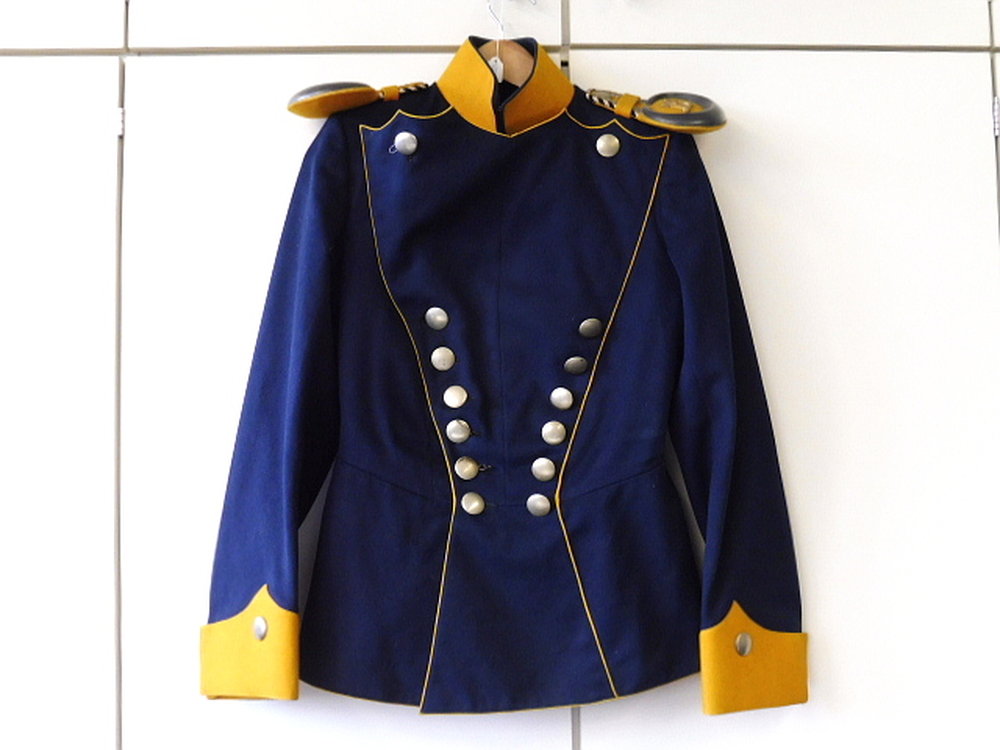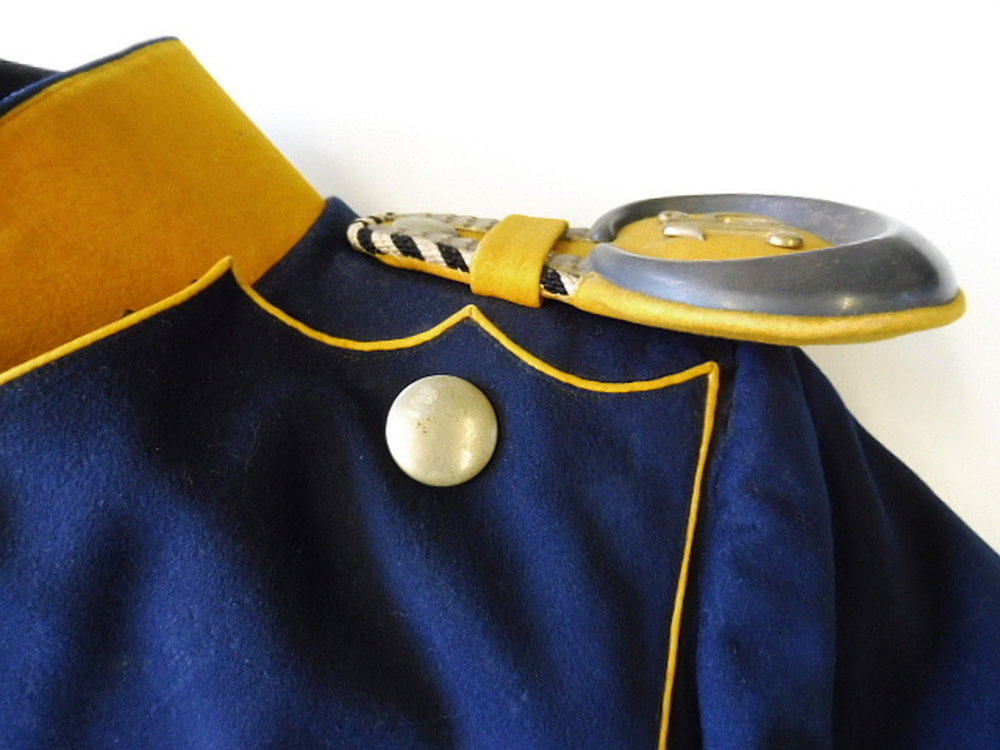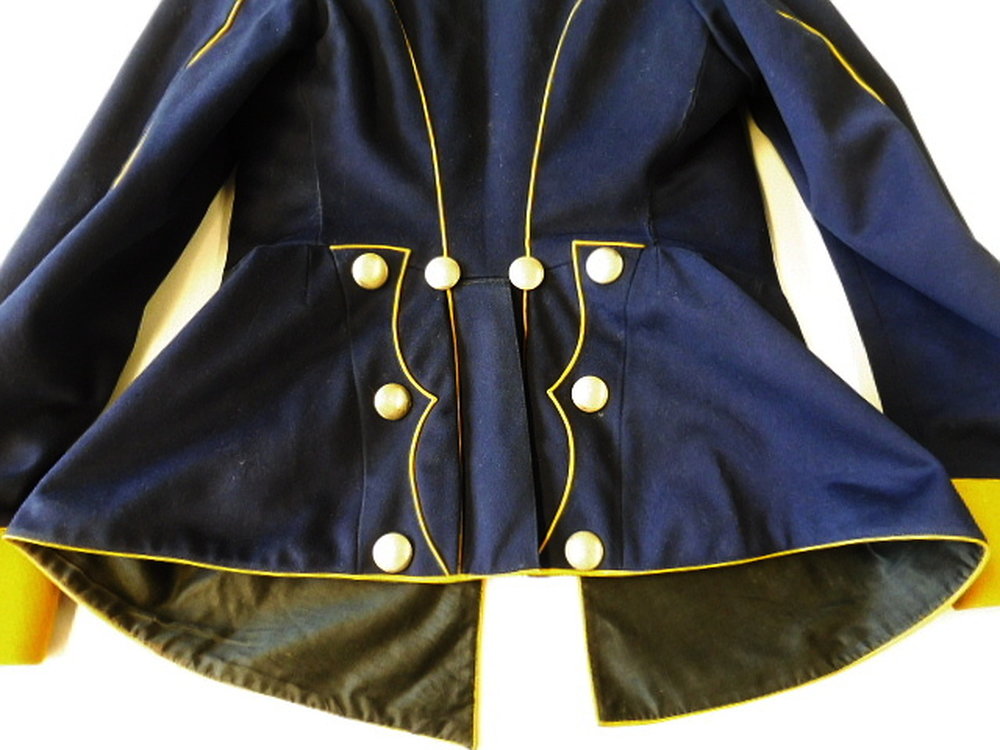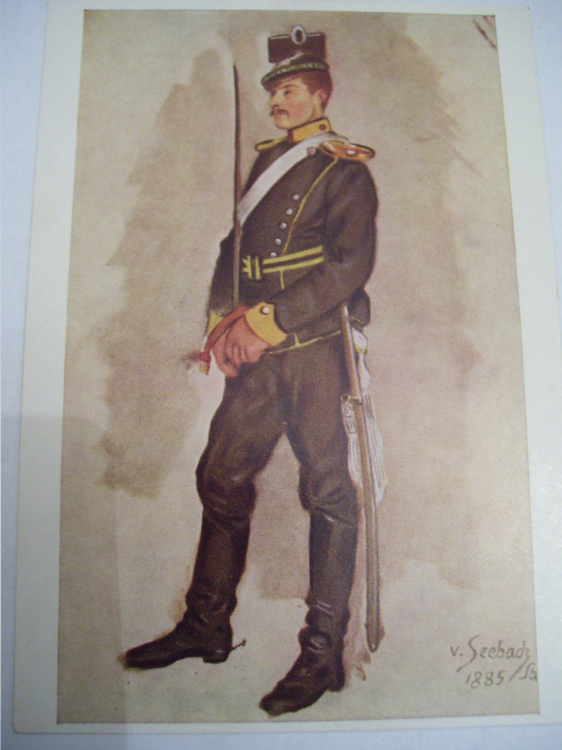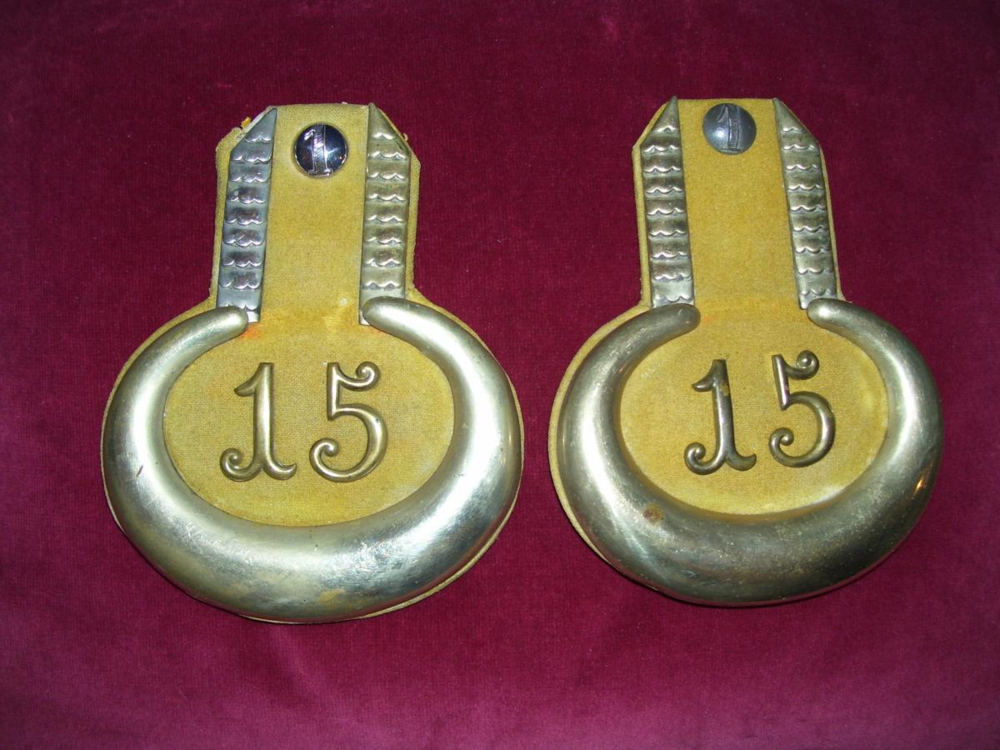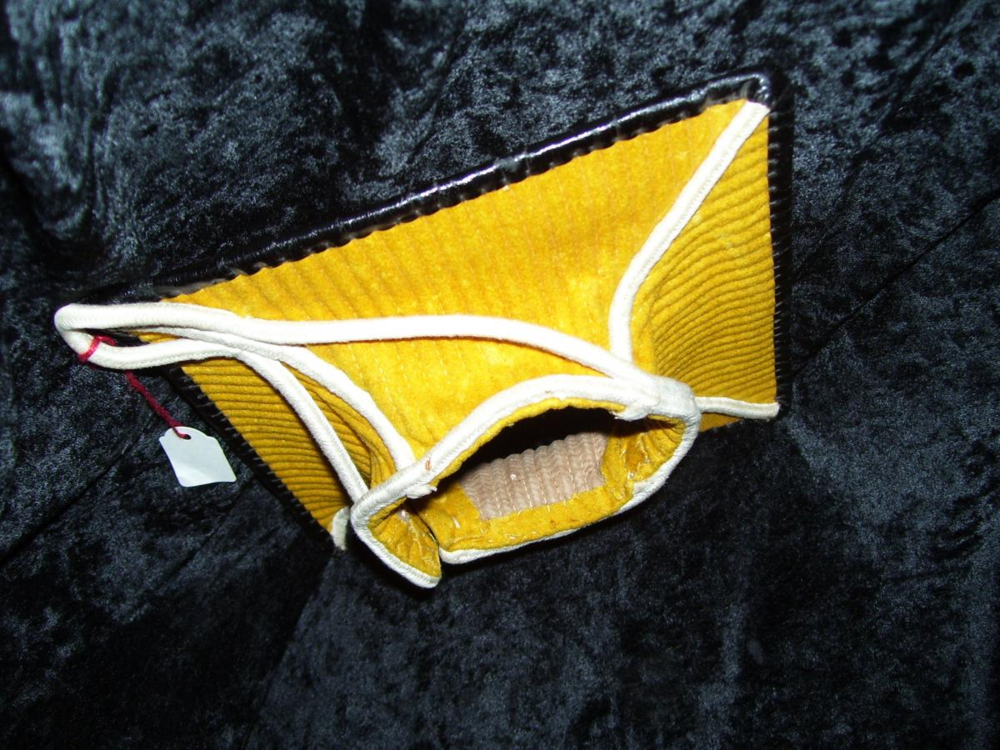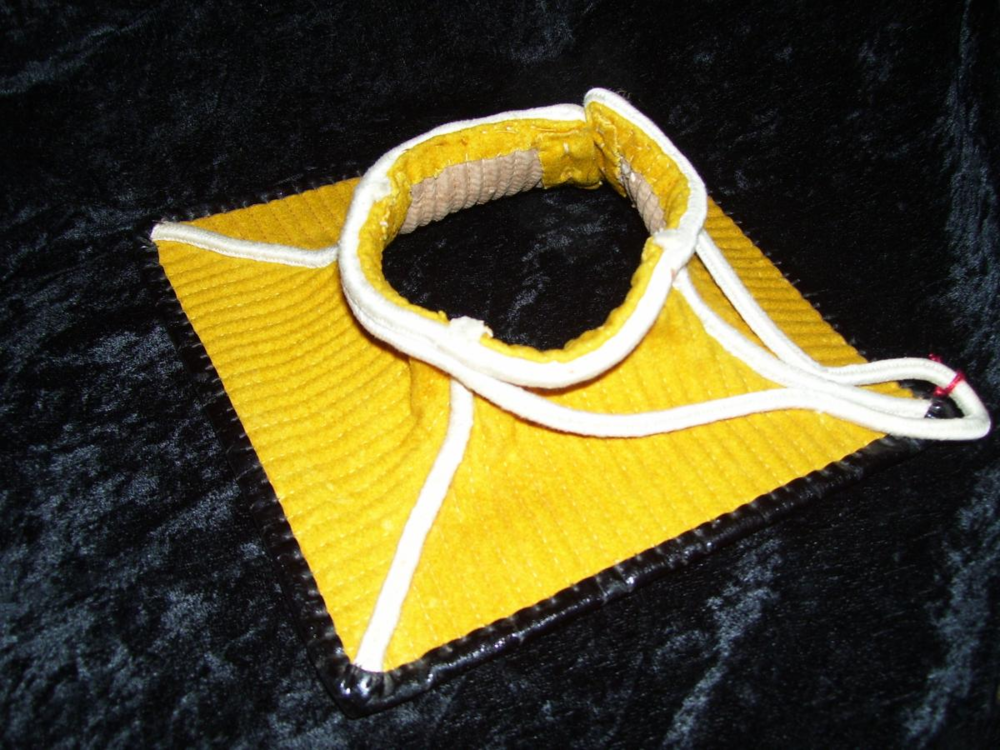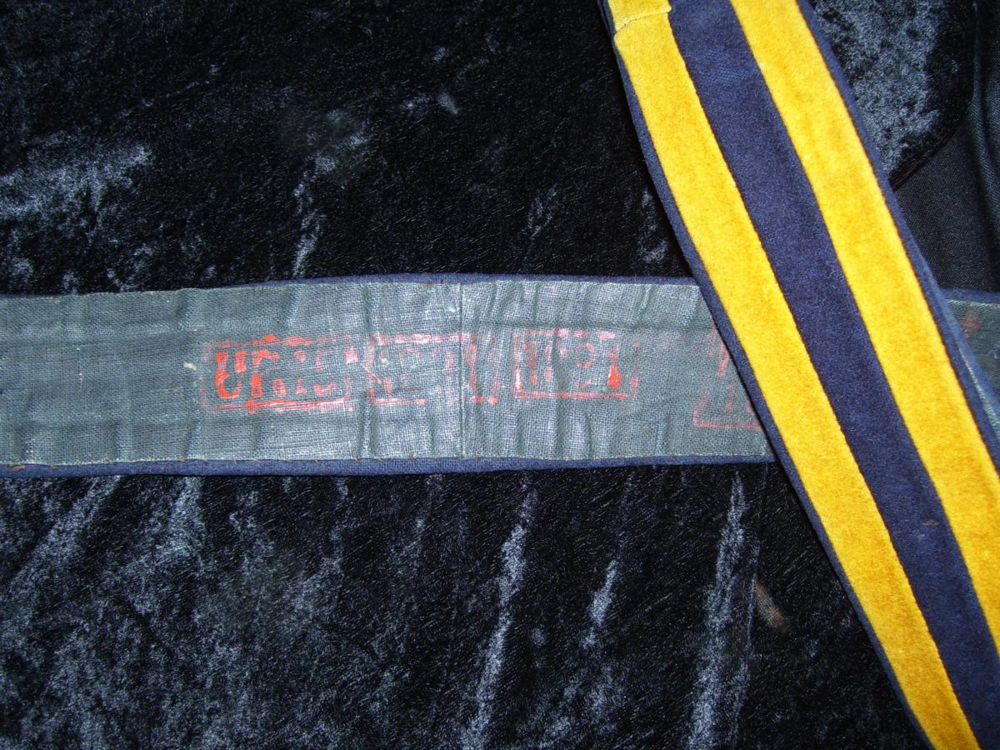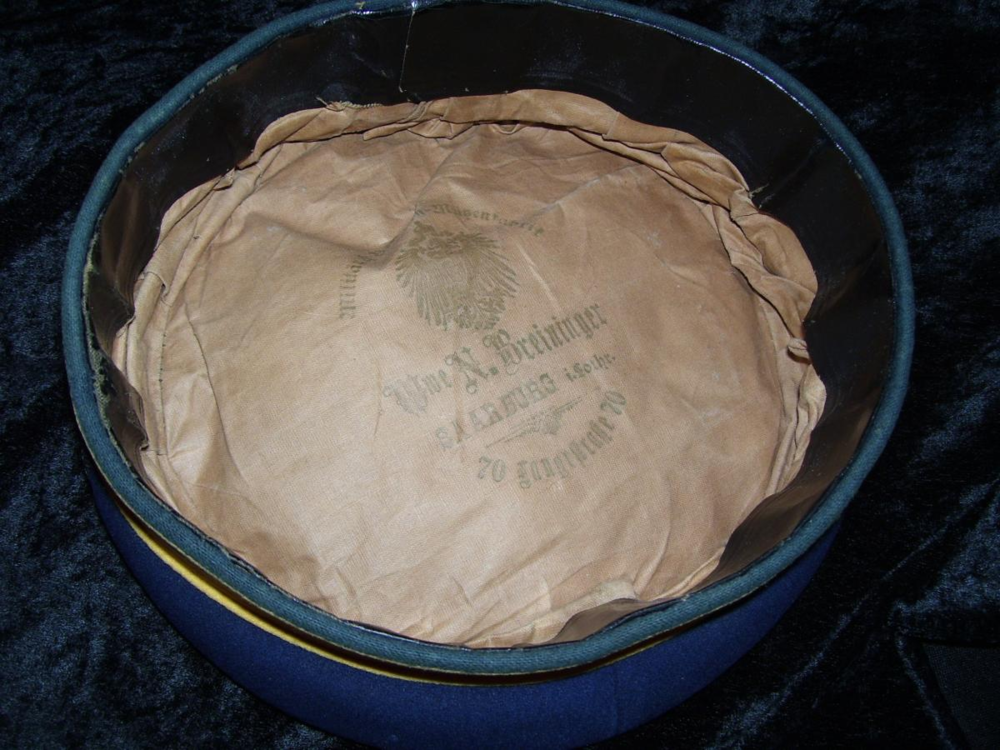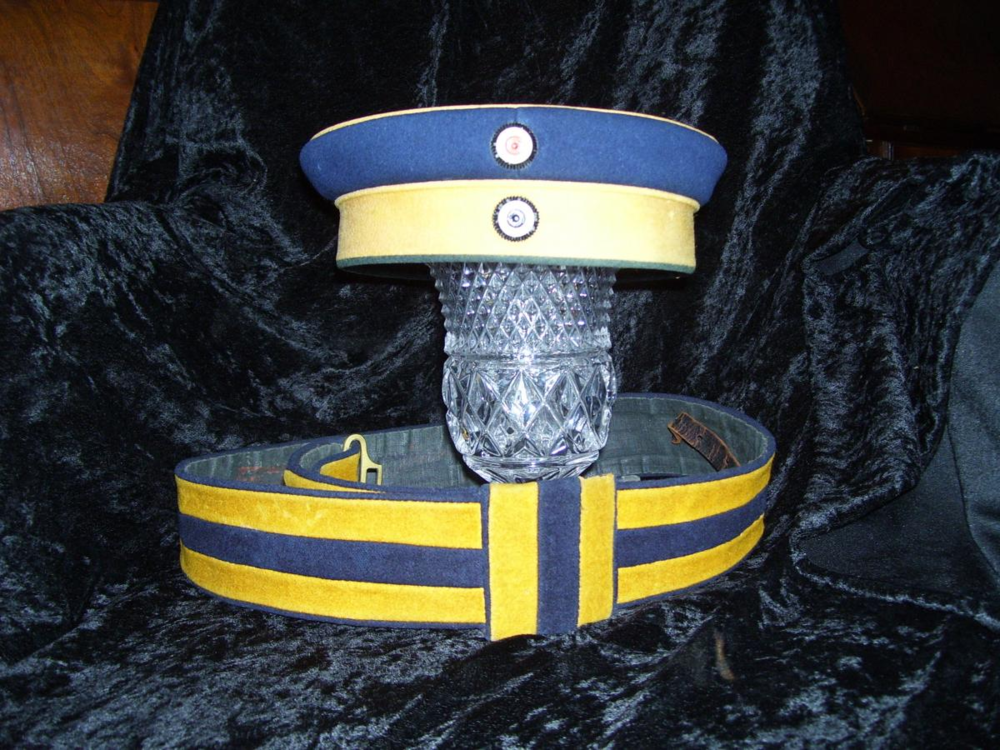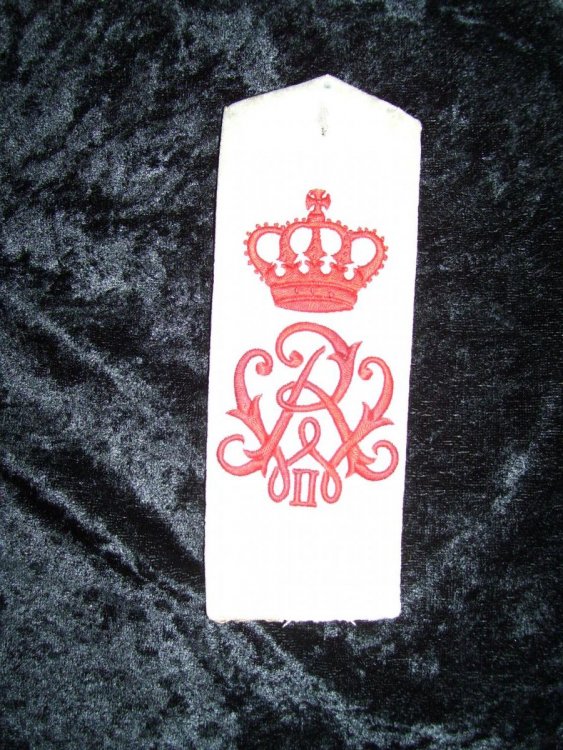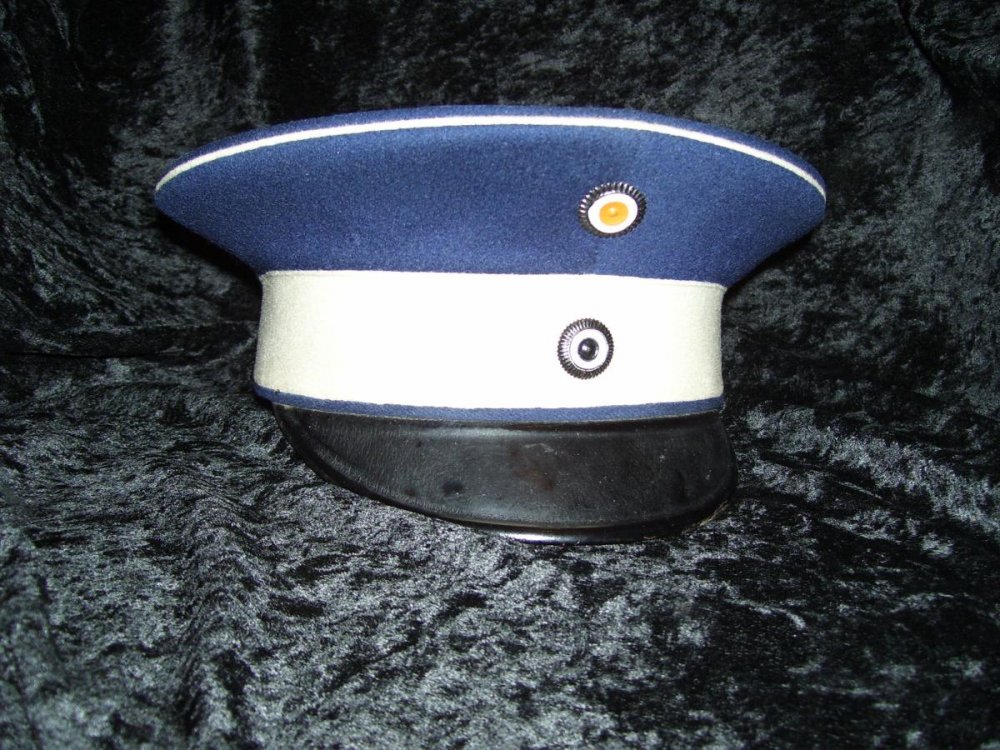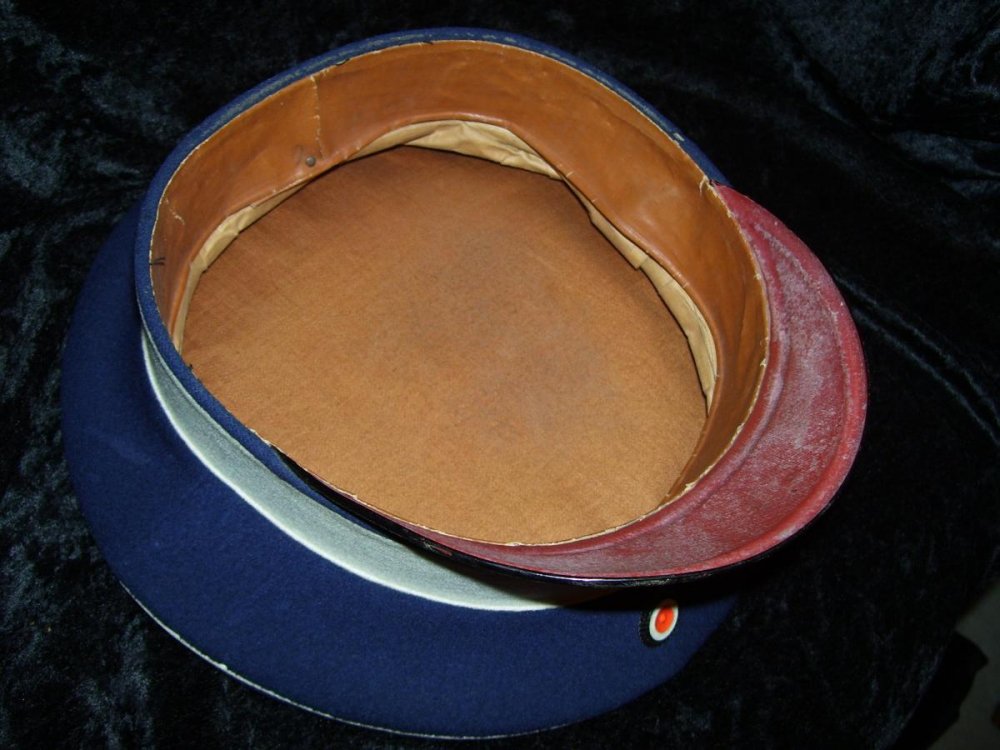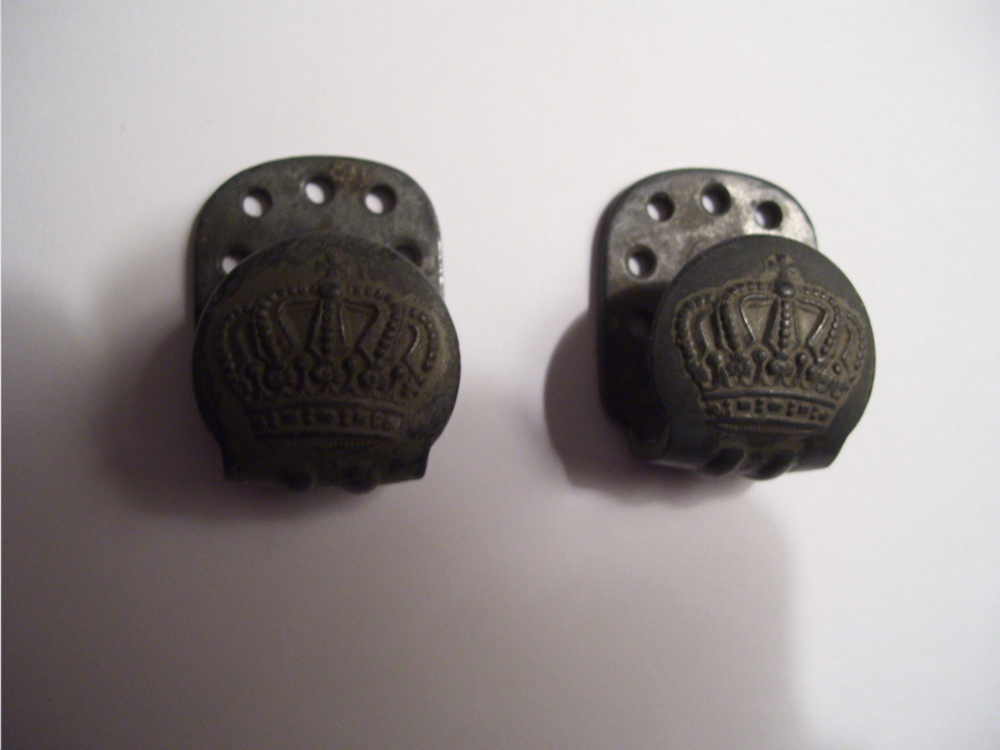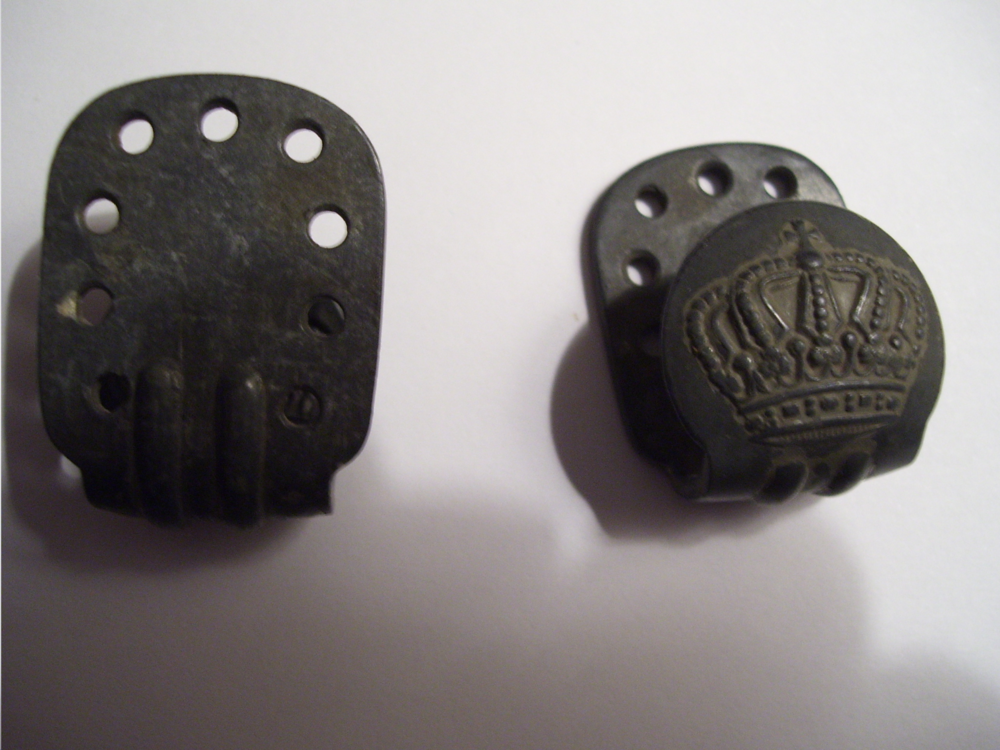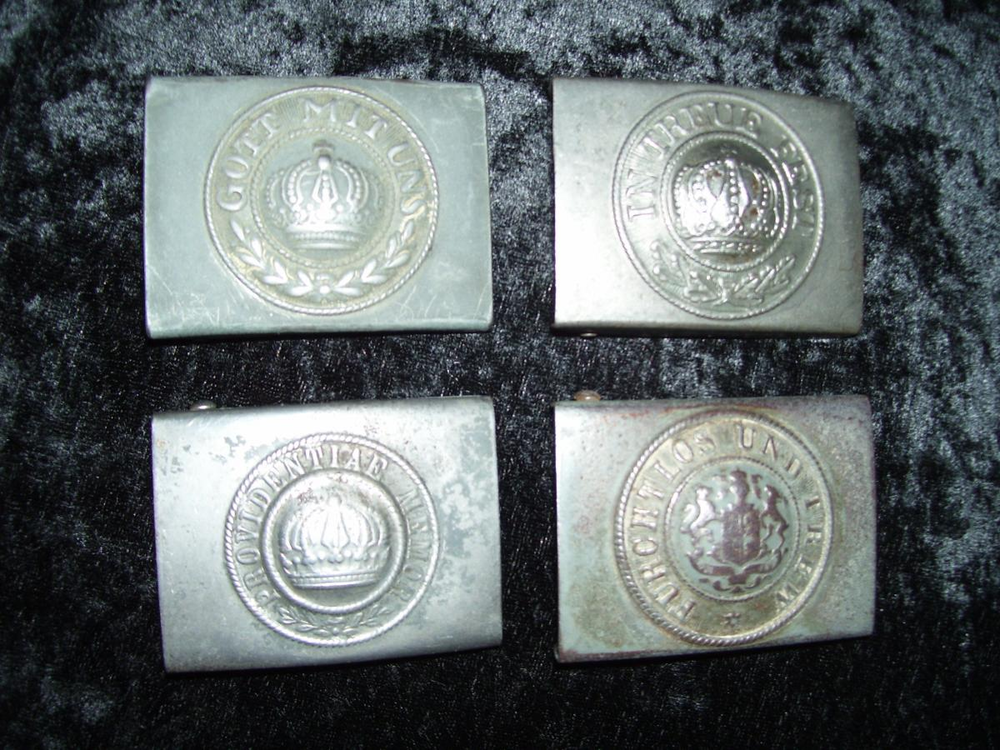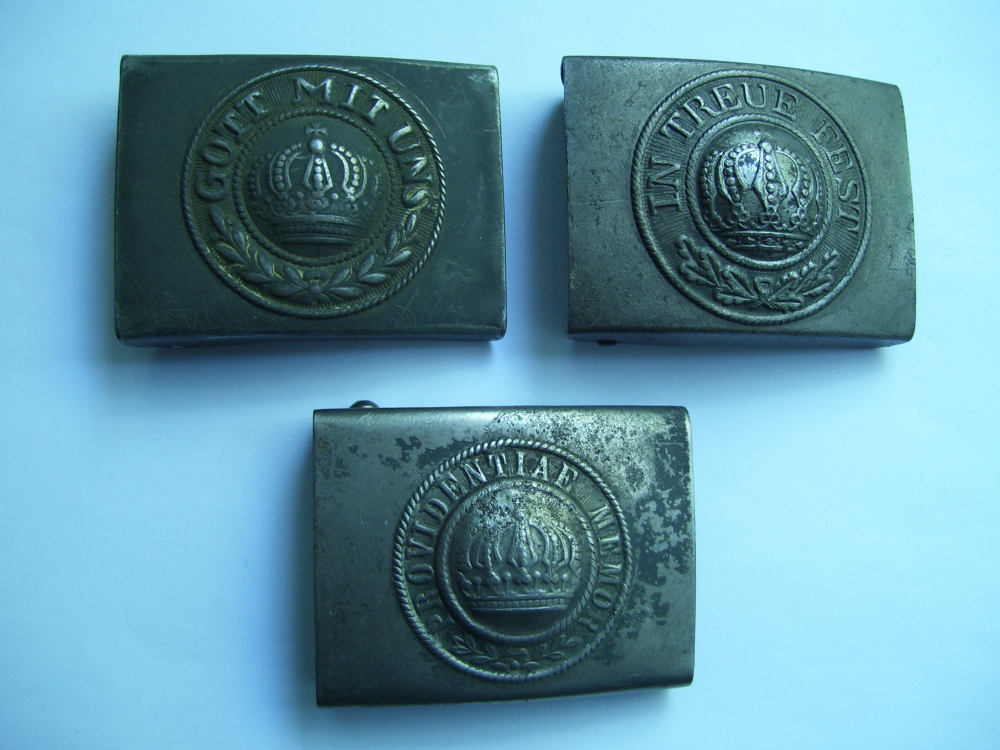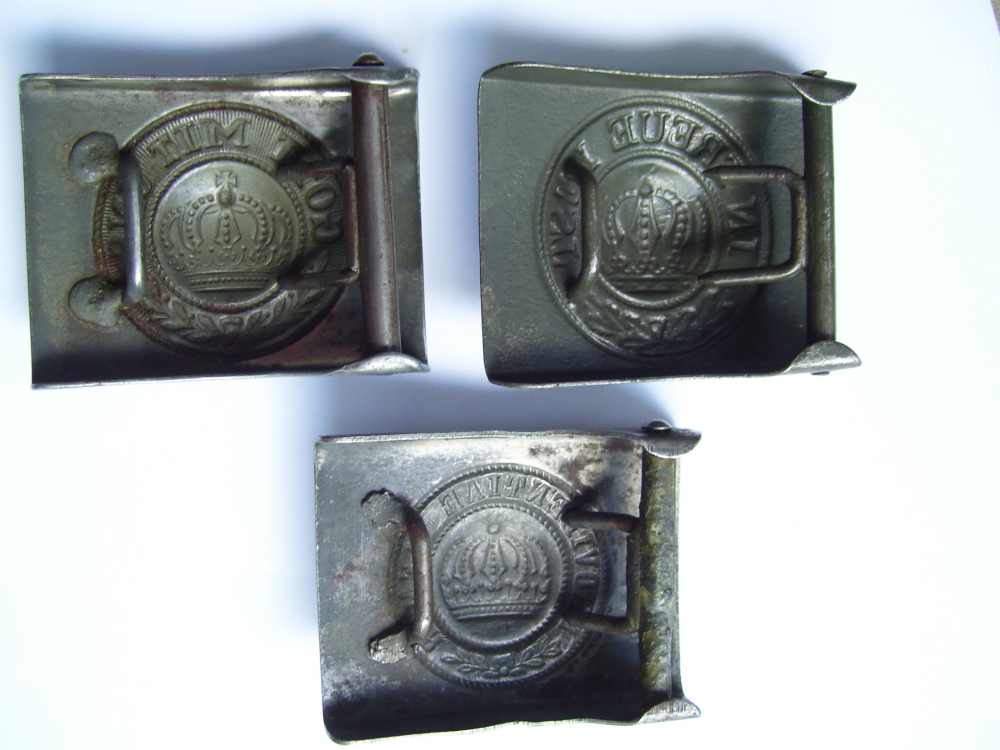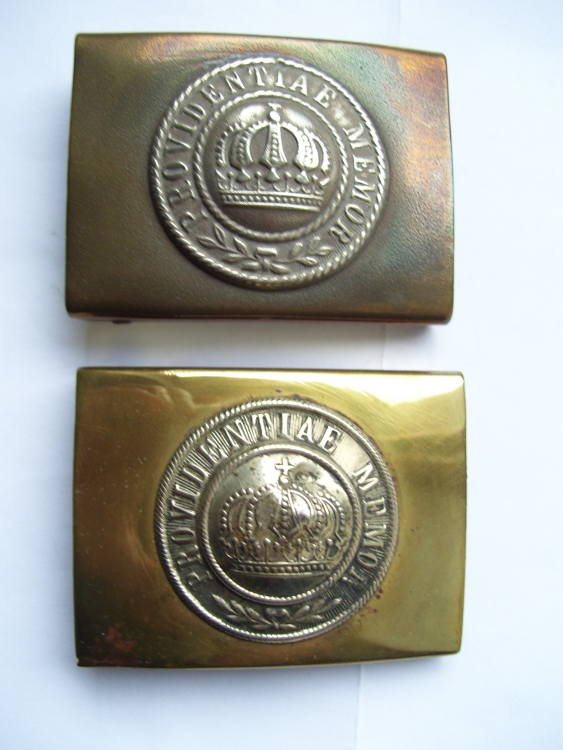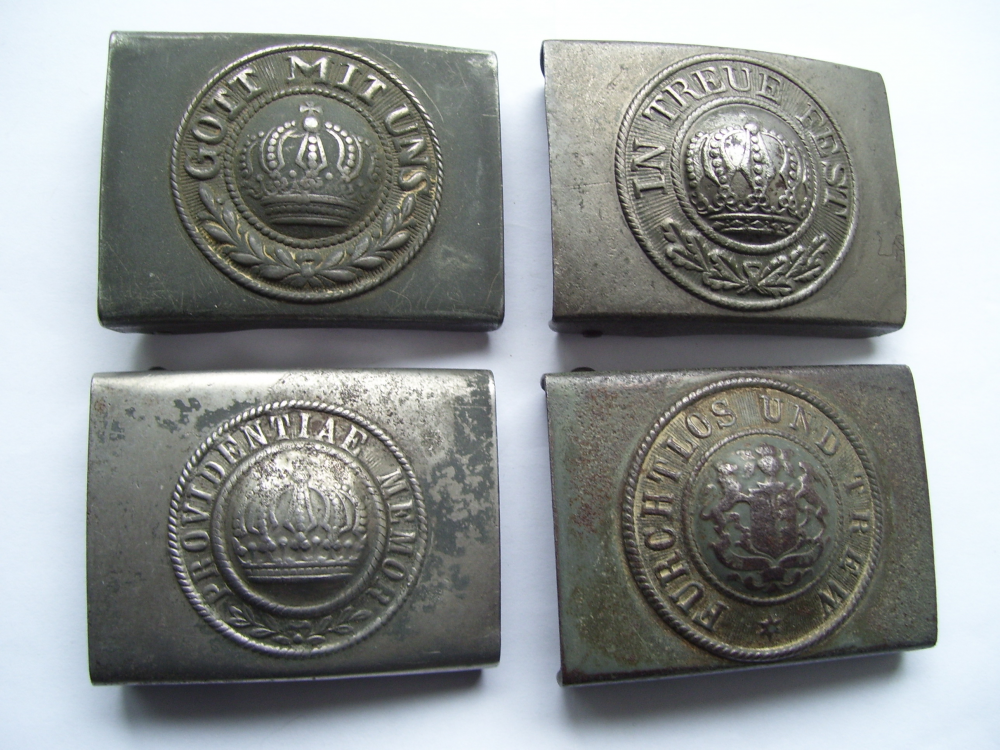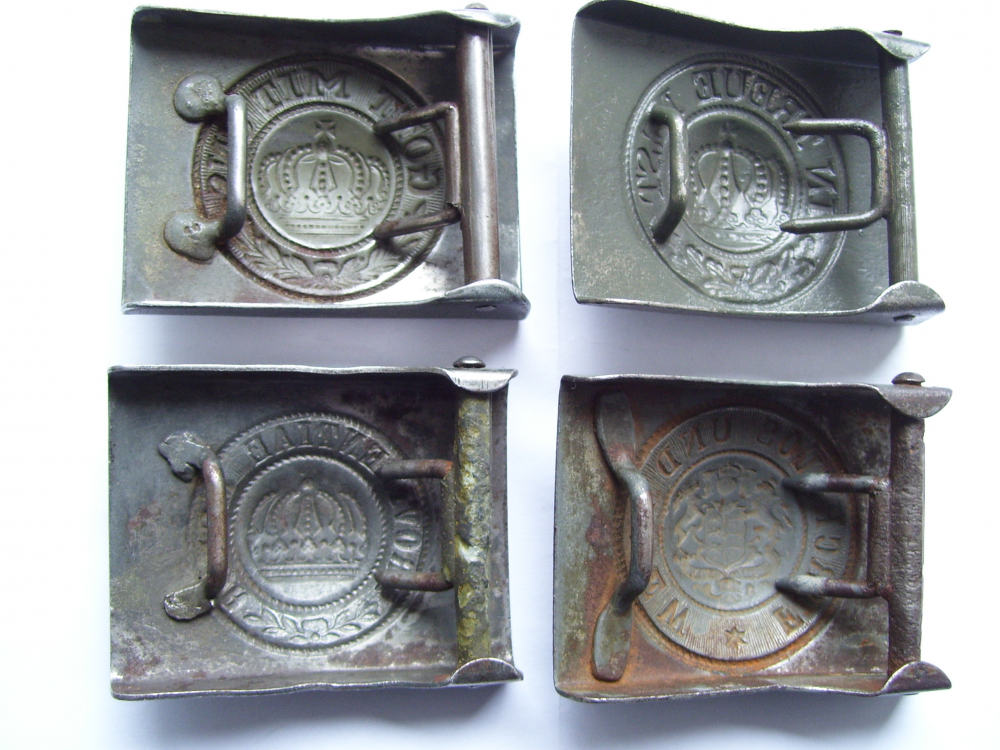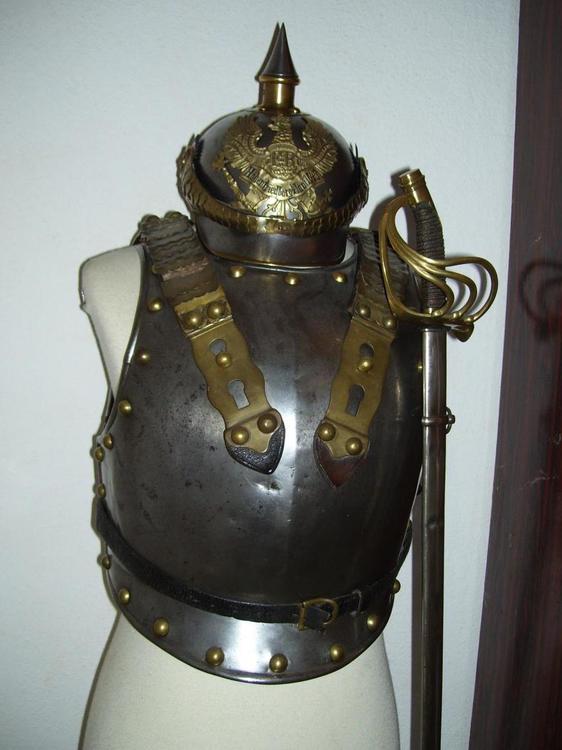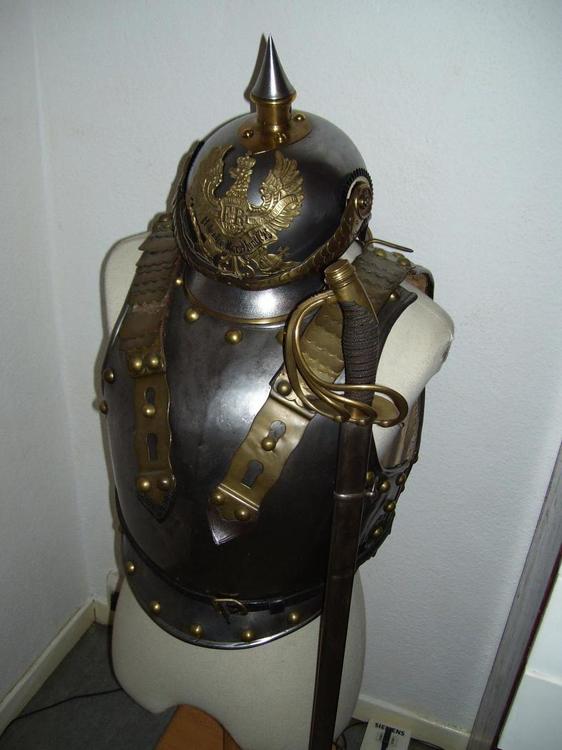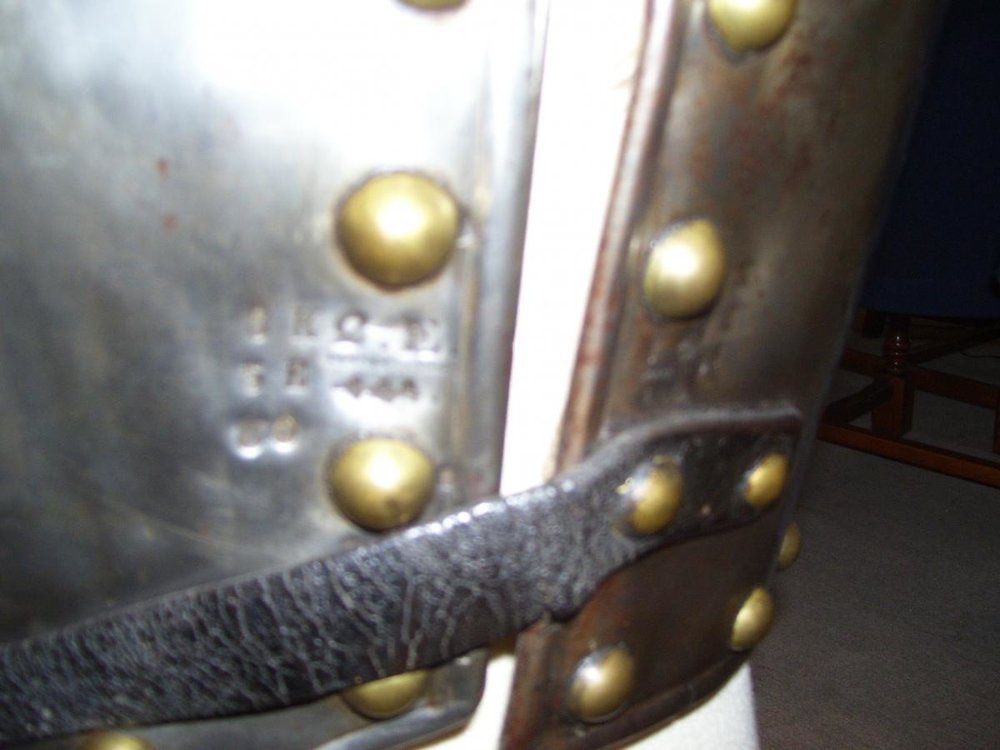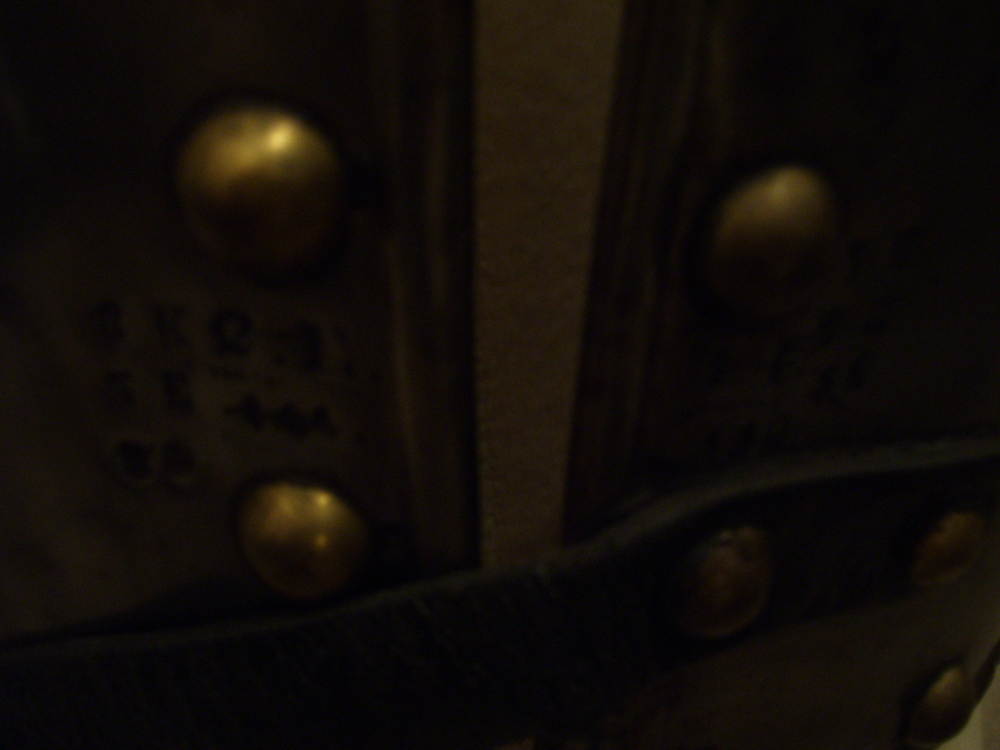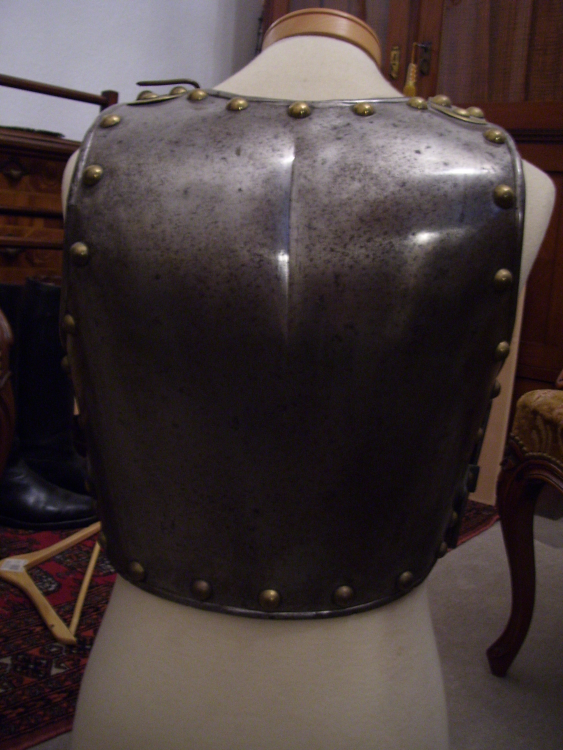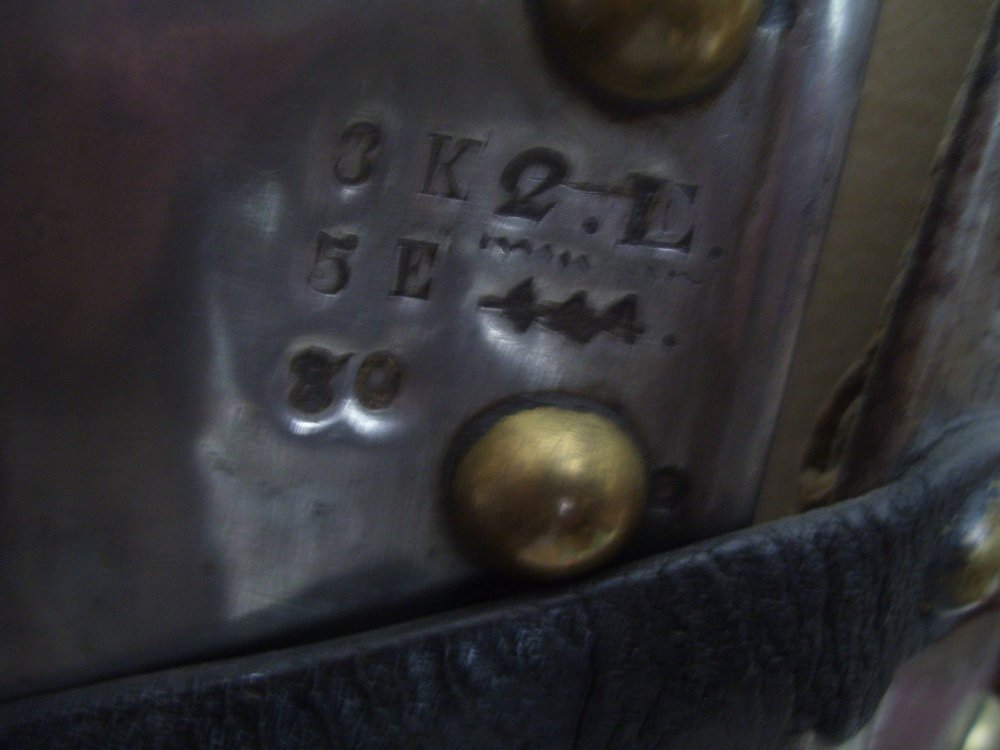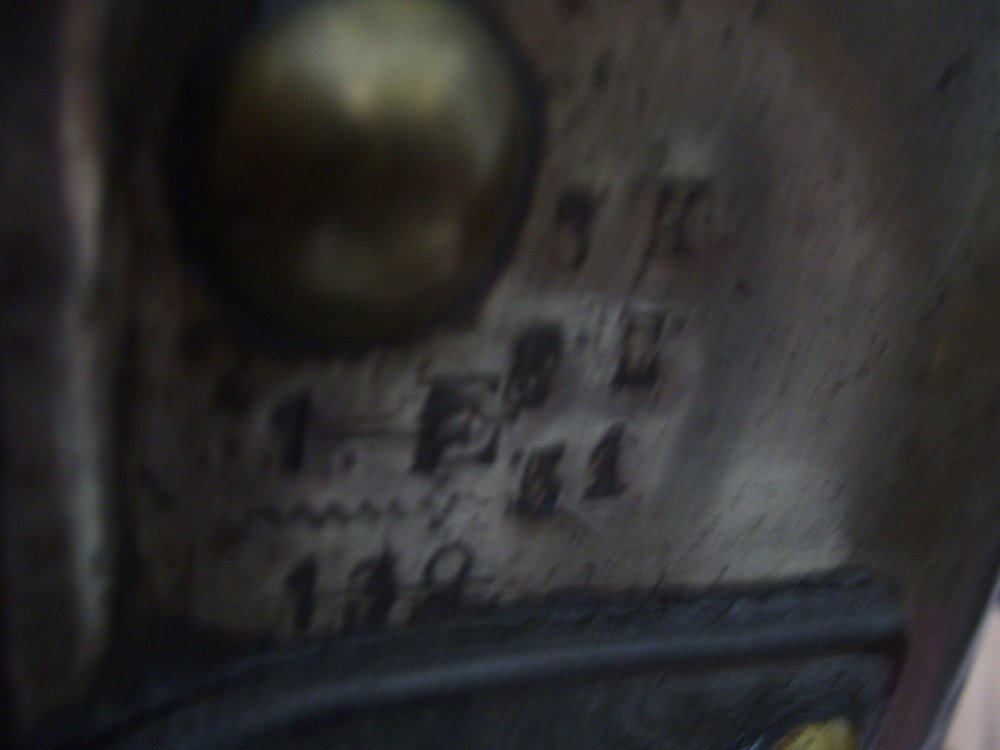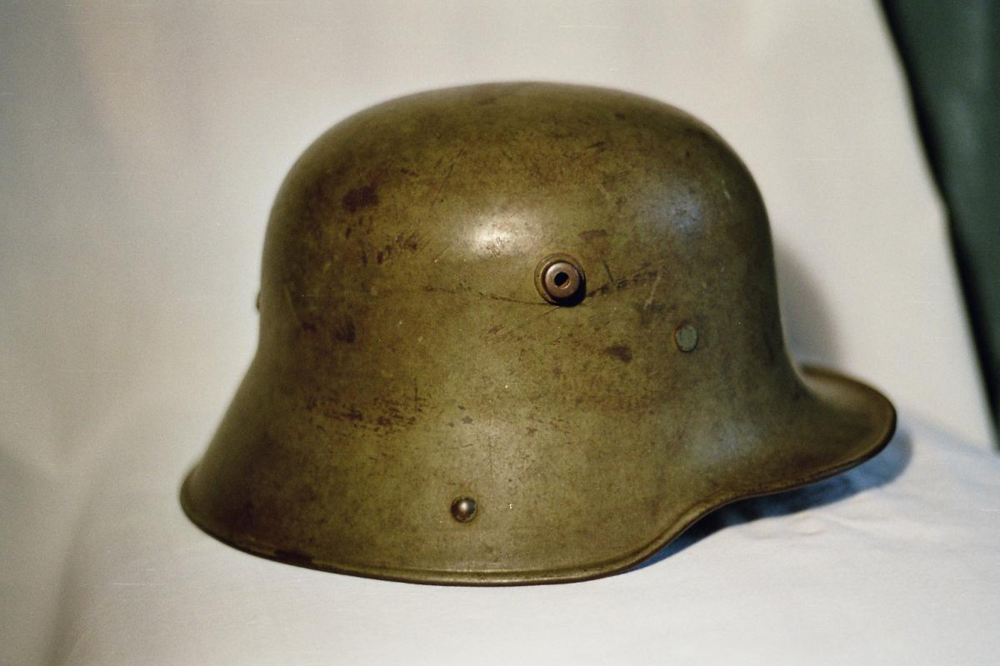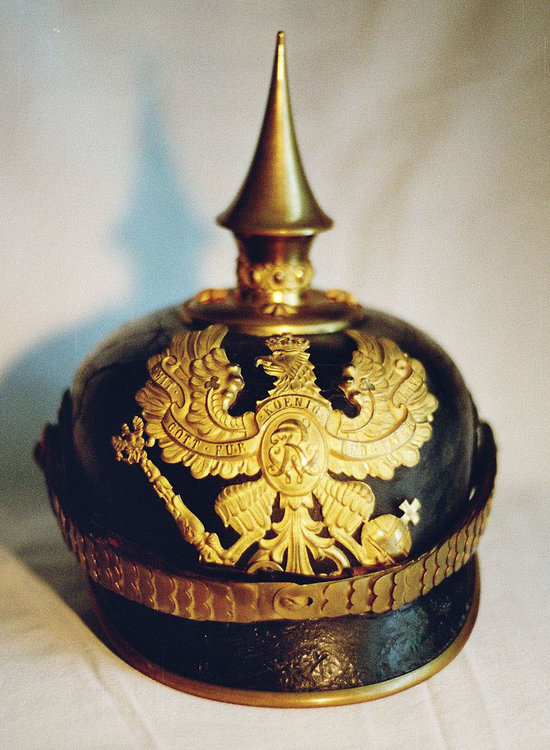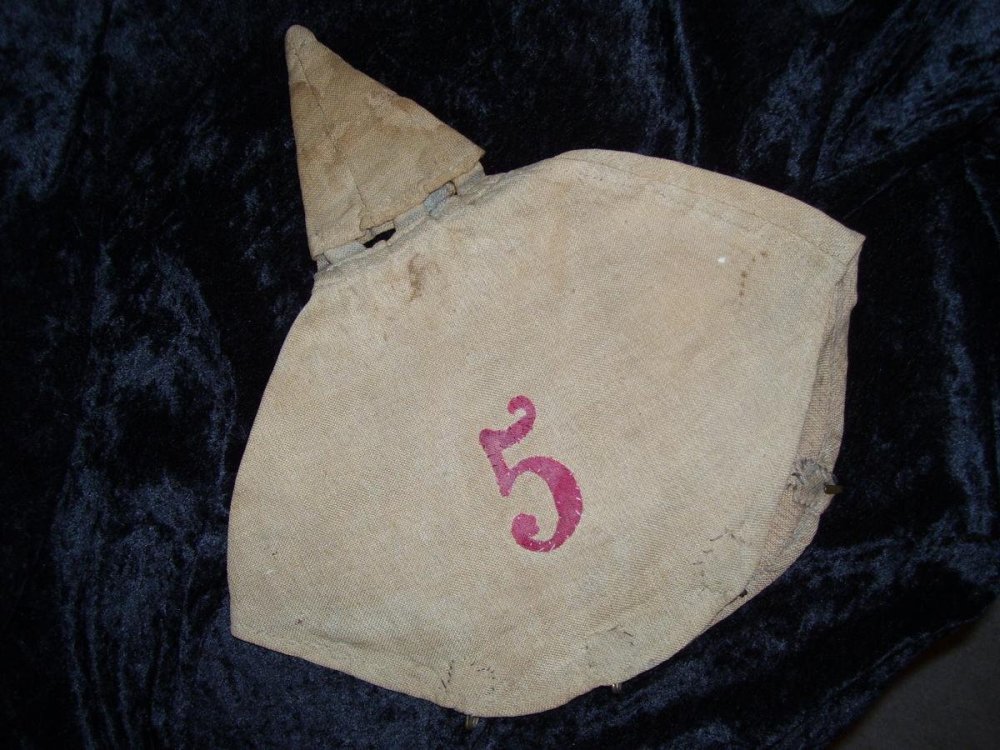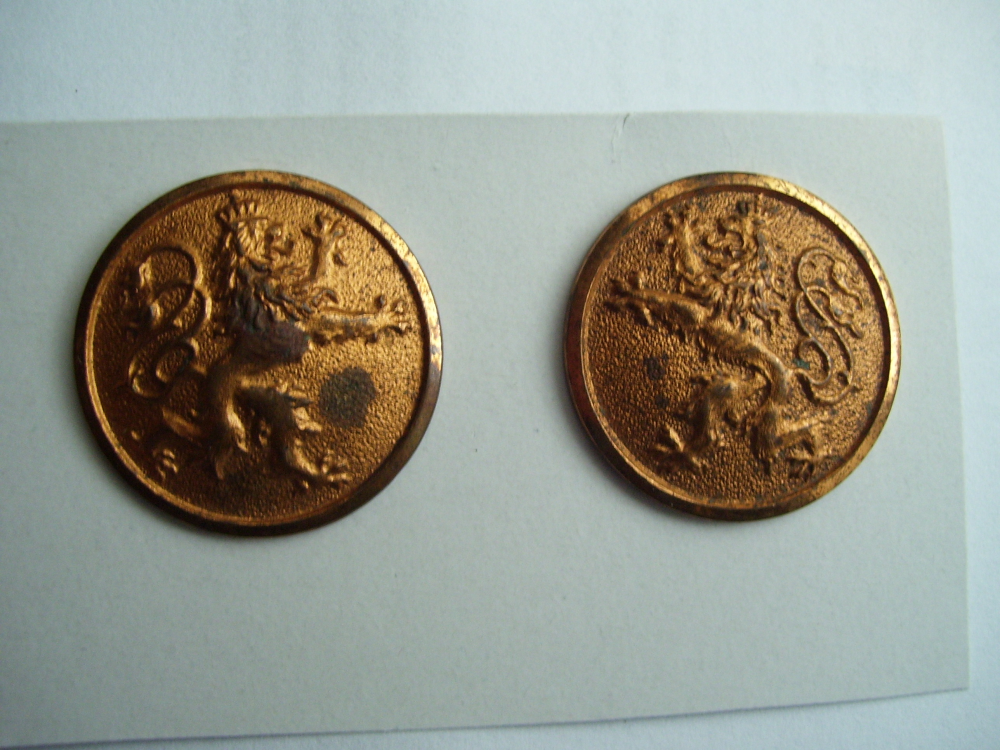Search the Community
Showing results for tags 'uniformen der alten armee'.
-
Peaked cap for other ranks for walking out dress from Royal Saxon 5. Infanterie-Regiment No.104, 8th Company, based in Chemnitz i./Sa. Dark blue top, darker than in photo, red band and crown piping, small black lacquered leather peak, brown glazed calico lining and leather sweatband with silver embossed maker's mark Franz Ruttloff, Chemnitz, Lange Strasse 51. There is an issue stamp: 104.R., 8.C. and a large stamped E, meaning that the recruit has purchased the cap for his own property, E meaning "Eigenthum". The cap can be dated around 1897 to 1900 by its low shape, and the Reichskokarde was added after 22. March 1897. The regiment was formed in 1701 and belonged to the XIX. Army Corps. The state cockade is white with a green ring. A considerable quantity of Saxon items has emerged on the market since the re-unification in 1990, this item purchased then.
-
Uniform accessories for an officer of Husaren-Regiment 15: See also previous articles about Husaren-Regiment 15 Officer's cap, worn by Major Freiherr von Tettau. Bandelier and Kartuschkasten with crowned FWR monogram. The bandelier is backed in blue uniform cloth as per the Attila, with silver brocade and silver plated fittings. Worn from the left shoulder to the right hip - the buckle to the rear. Säbeltasche, yellow cloth, silver braid, red maroquin leather, hangers of patent leather with fire-gilded bronze fittings The Säbeltasche is in need of some restoration, yellow cloth is faded, the braid has at some time been overpainted with silverbronze, which requires carefull removal. All extremely rare items. Kavallerie-Degen 89, non-issue, with engraved Regimental motives. Members badges for the Regimental associations (later)
-
Shoulder strap, September 1915 for Feldartillerie-Regiment Prinzregent Luitpold von Bayern (Magdeburgisches) No.4 based in Magdeburg, raised 1814. As from September 1915 shoulder straps for all field artillery units were bright red. Backing in fieldgrey. Below the crowned monogram of PRL is a flaming artillery grenade. Prinzregent Luitpold ruled Bavaria from 1886 till 1912 (Interregnum). The regiment belonged to the IV. A.K. (Prussia) Shoulder strap, 1914/15 for 1.Feldartillerie-Regiment Prinzregent Luitpold (Bavaria) based in München, raised 1824 and belonged to the I. Bavarian Armee Korps. After the outbreak of war, some shoulder straps were subject to simpified manufacture and without piping. On rough stonegrey serge. Monogram PRL slightly faded, damage to crown. The Bavarian artillery regiments wore no grenade on shoulder straps Königlich Bayerisches 1. Feldartillerie-Regiment Prinz-Regent Luitpold, Einjährig-Freiwilliger
-
Bavarian cap cockades: Officer Reserve-Officer Other ranks' field cap (stitched on) Pair of rank buttons for Feldwebel, M.1916, silver subdued (see previous article) Rank buttons for Gefreiter, gold, various singles, one right and two left, pre 1916 Bayern, Sergent - Feldwebel, Rangknöpfe
-

Ulanen-Regiment 15, Uniform Accessories and Epaulettes
Fritz posted a topic in Uniforms, Belts and Buckles
Schleswig-Holsteinisches Ulanen-Regiment No. 15 Commander in Chief: Generaloberst Prinz Leopold von Preussen, K.H. Commander: Oberst von Printz Garrison: Saarburg/Lothringen (XXI. Armeekorps) A matching pair of Epaulettes for other ranks or n.c.o. ca. 1880-1890. These are considerably larger than later examples. Buttons of 1.Eskadron, one of which is a replacement. Traces of age and wear. Peakless cap and Pass-Gurtel for other ranks or n.c.o. The cap has a maker's name, Uwe N.Breininger, Militair Mützen Fabrik, Saarburg i./Lothr., Lange Str.70. The belt has a red ink stamp of U.R.15 Further photos are of a yellow Tschapka-Rabatt, which was fitted around the Tschapka throat for parade and full dress . The braid loop is for attachment of the cap-lines when worn. The Rabatt is for the older Tschapka model of 1867, which had a larger top than later models. Uniform: Dark blue "Ulanka" with yellow facings, white metal buttons. Tschapka with white metal fitings. The regiment formed a joint brigade together with Ulanen-Regiment 11, also based in Saarburg. The regiment was raised in 1867 and first based in Perleburg, Kyritz and Wusterhausen. After the war of 1870/71 the regiment was based in Strassburg/Elsass. In 1896 it moved to Saarburg. In August 1914 the regiment saw duty in patrolling the frontier in Lorraine. In September it took part in the advance to Amiens and Compiègne. After the retreat, the regiment was sent to the coast during the "race to the sea", where it saw service as dismounted infantry until December. The joint brigade then saw service till April 1915 in the Vosges and was involved in the fighting around Hartmannsweiler-Kopf. The brigade then saw service in the rear areas in Belgium. On 15th December 1916 the brigade was sent to the Eastern Front, where it remained till the end of March 1918. It was in the line at Dünaburg and advanced to Estonia and Livland. After the return to the Western Front, the brigade was converted into a fighting unit and from May 1918 took part in the defensive battles till the end of the war. After the return home, the brigade was demobilised in Osterburg/Altmark. The tradition of the regiment was maintained by 3rd Squadron, Reiter-Regiment No.11 in Gera. Further illustrations of a Ulanka of U.R.15 for a one-year volunteer, very similiar to the example I once had. Illustration by A.v.Seebach, 1885 of an Ulan (Gefreiter) of Schleswig-Holsteinisches Ulanen-Regiment 15 -
A peaked dress cap - Schirmmütze for other ranks walking out dress of Königs-Ulanen-Regiment (Hannoversches) No. 13 based in Hannover. Cap can be dated as around 1914. To compliment this is an other ranks' shoulder strap for the greatcoat, peacetime wear. Otherwise metal-edged epaulettes were worn. The shoulder-piece is in the regimental colour, white and bears the crowned monogram of it's honorary commander-in-chief, Kaiser Wilhelm II., this example is hand-embroidered. Certain items from this popular regiment often turn up on the collector's market, usually epaulettes, tunics, caps and occasionally swords with regimental engraving. Other items from this regiment, however, are considerably rarer.
-
A pair of rear tunic buttons (belt hooks) worn on the M.1915 Bluse or blouse as per the regulations of September 1915. The Bluse had at the front concealed buttons, the only insignia buttons were on the shoulder straps with a company number, the side pockets and the two over the rear vents, serving as belt hooks. These were made of zinc galvanised steel, and were finished in either grey for the previous silver colour, or brown for the previous copper bronze colour. This set of buttons was obtained from a militaria dealer in the antiques passage in the centre of East Berlin (formerly Clara-Zetkin-Straße) in early 2006. As they are in the grey colour, they can be attributed to either 1.Foot Guards, Garde-Füsilier-Regt., 5. Garde-Regiment zu Fuß, or Garde-Pionier-Bataillon, but as the Garde-Füsilier-Regt. was stationed nearby, it is probable that they can be attributed to this regiment N.B.: The 1915 tunic or Bluse is often incorrectly referred to as "Feldbluse" in collectors' circles. This latter term only applies to uniforms of the Weimar period and Third Reich. In official period literature this was the "Bluse". The "Bluse" replaced the previous "Waffenrock". The 1915 pattern buttons had a brown or grey finish in place of the previous gold or silver metal colours, Tombak / Nickel
-
Here, a selection of belt buckles of the main German states, M.1915, all in fieldgrey. Note the differences between the three various crowns. Prussia / GOTT MIT UNS Bavaria / IN TREUE FEST Saxony / PROVIDENTIAE MEMOR Württemberg / FÜRCHTLOS UND TREW (treu) Other German states had their own patterns, such as Hessen, Mecklenburg-Schwerin and Mecklenburg-Strelitz. Saxony also had further variations for I.R. 107 and 108, and for Leib-Grenadier-Regt.100. The new buckles were made by a variety of manufacturers using Siemens-Martin Stahlblech (a patent), which was zinc coated and then finished in field grey. Improved pictures, 27.6.2020: Prussia, Bavaria, Saxony. The reverse of Bavarian buckle has been overpainted by a previous collector. Saxon buckle has some old pitting above the crown, some original finish remaining. Further 2 examples of Saxon buckles M.1895, brass with nickel centre.
-

Prussia, Kürass, Heavy Cavalry Breast- and Backplate
Fritz posted a topic in Uniforms, Belts and Buckles
Prussian Heavy Cavalry Breast- and Backplate A Kürass of the Prussian heavy Cavalry, as worn by all eight line regiments. The breast and backplate have both original rough white linen liner, the breastplate has a large pocket in the liner for the field cap. There is a cloth name tag attached, Kürassier Lindau, Kür.8, 5. Esk. Both steel pieces are stamped under the left armpit with regiimental details, at slight variance: 8.K. 2.E. the 2E has been stroked out and replaced by 5.E.30, being the 5th squadron, weapon no.30. The backplate has 8.K. 5.E. and a weapon no.31. The piece is undated, but can be dated between 1888 - 1914. In the 1850s new cuirasses were made to replace the old models from the Napoleonic Wars, mostly of captured French stock. In 1888 the cuirass was abolished for field service and retained only for ceremonial occasions. New cuirasses were then introduced, being of a thin leightweight steel, no longer protective. The cuirasse was then officially abolished in January 1916 with the old coloured peacetime uniforrms. The cuirasse was always worn with a white leather shoulder bandelier with black cartridge box, or Kartuschkasten. This was fitted with a round brass medallion with the Prussian eagle and trophies A broadsword or Pallasch was worn. The example shown belonged to Kürassier-Regiment Graf Gessler (Rheinisches) No.8, of whom King George V was the last honorary commander in chief. This regiment wore a white Koller with bright green facings and yellow metal buttons, the shoulder straps bore the crowned monogram of King George V.. The cuirasse is displayed with a helmet of Kürassier-Regt.2, not matching. -
German M.16 Steel Helmet This nice old helmet I acquired from a second hand shop in London on 12th September 1964 and it cost the princely sum of 40 shillings or 2 pounds. The dealer wanted originally "our price 45 bob", as they said in those days. I bargained a little, agreed on 2 pounds and left a deposit of ten shillings, and then started saving my pocket money like mad, and about one month later I paid the rest and was the pround young owner of a German Steel Helmet. At first I wondered a little at the curious shape and with the horns, but then after looking at many pictures, tv-documentaries about the Great War and WWII, I realised it was a WWI piece. Was still very proud of this old piece. The helmet in is very good condition, as fresh from the, possibly, Somme battlefields, just as brought back. Paintwork is astonishingly intact, just minor wear, the leather liner complete and fresh, just slighly wear stained. The original brass strap holders were still in place, no strap. Later learned that these straps were taken from the pickelhaube when the steel helmet was worn. The first steel helmets were left in the trenches when the troops were relieved, and these handed over to the newcomers. This helmet bears a stamp ET64 shell size 64, and produced by the Eisenhüttenwerk in Thale/Harz, one of the first manufacturers. Inside the shell is a small stamp: R/18, presumably Infanterie-Regt.18, which was based in Posen. The first steel helmets were issued for the assault on Verdun, but only in very small numbers, until gradually production capacities increased, so that most infantry had helmets by August-September 1916. The first steel helmet appeared in February 1916 in small numbers on the Verdun Front - 100 years ago
-
Shown is an officers helmet, basic pattern for Grenadier Regiments 1-12, except for G.R. 1,4,7 and 9, which wore helmets with the Grenadier eagle, old or new pattern and with battle honours etc. The old pattern eagle shown is pre 1913. The new pattern eagle was introduced gradually for all regiments between 1897 and 1913. Shown is the old pattern heraldic eagle with an oval FWR shield on the breast. The helmet is presumably from Grenadier-Regiment König Friedrich I. (4. Ostpreussisches) No.5, based in Danzig, as it came complete with cloth cover and red regimental number. The eagle displays a very fine quality fire-gilding. Inside is the normal officers type lining in leather and ribbed silk, the front peak is lined in green leather, the rear peak in red leather, which was standard for officer helmets. This example could be dated as around 1897-1910, probably the latter, as the spike is relatively tall. Correction: Title of Regiment should read: Grenadier-Regt. König Friedrich I. (4.Ostpreussisches) No.5 - based in Danzig. Friedrich I was the first King of Prussia since it's establishment in 1701. This cover came with the helmet, however, this is an other ranks' issue, but may have been worn with such
- 83 replies
-
- 4
-

-
- helmet
- uniformen der alten armee
-
(and 1 more)
Tagged with:
-



